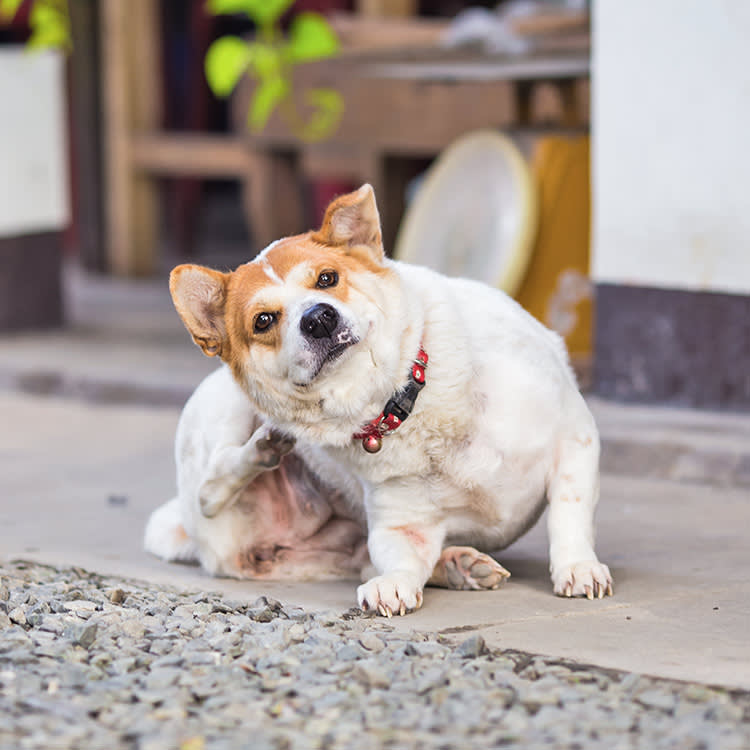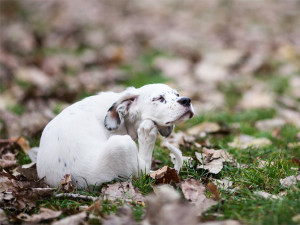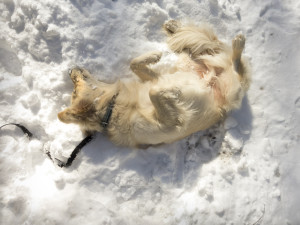Top 6 Reasons Why Your Dog Is Itching and Losing Hair
No fleas, but still itching? Here’s (maybe) why.

Share Article
In This Article:
Symptoms That Accompany Dog Itching and Hair Loss Six Common Reasons for Dog Itching and Hair Loss How a Vet Diagnoses Dog Itching and Causes of Hair Loss Treatment for Itching and Hair Loss
It’s one thing for your dog to itch. But when they keep itching and itching (accompanied by some possible hair loss) — and you haven’t spotted any fleas — this can turn into a CSI-esque quest to figure out what the heck is bugging your poor pup. If you’re baffled, that’s OK. We’ve been there, too.
Read on for help in figuring out why your dog may be experiencing unrelenting itching and hair loss, other symptoms that might accompany this, as well as how you can remedy the situation. From infections to allergies to nutritional deficiencies, we cover all the bases.
Main takeaways
It is common for dogs to experience itching and hair loss.
There can be additional symptoms to watch for.
There are six common reasons why dogs get itchy and lose hair.
Vets may need to run some tests to find the cause of the itchiness and hair loss.
There are medications, skin care products, environmental changes, dietary changes, and home remedies for treating your dog’s itching and hair loss.
Dog itching and hair-loss symptoms to watch out for
It’s normal for your dog to occasionally scratch or lick their skin and experience a certain degree of shedding. But when their scratching, licking, and hair loss become excessive, it’s time to look for the cause. There often can be additional symptoms or behaviors accompanying itchiness in your dog. They include:

Redness or inflammation
Scaly or crusty patches
Open sores or hot spots
Dry, flaky skin
Thickened or darkened skin
Pustules or pimples
Rubbing against hard surfaces
Restlessness
Weight loss
Lethargy
Loss of appetite
Red, inflamed ears
Frequent ear scratching or head shaking
Vomiting or diarrhea
Fever
Swollen lymph nodes
Symmetrical hair loss (often linked to hormonal issues)
If you observe any of the above in conjunction with hair loss or itching, a vet visit is strongly recommended. Finding the cause of these symptoms and behaviors is necessary to provide proper treatment.
Six common reasons why your dog is itching and losing hair
Reasons for your dog’s constant scratching and licking most commonly fall into one or more of the following categories.
Seasonal and food allergies
Your dog may be allergic to something. If the itching occurs mainly during a particular time of the year, it may be a seasonal allergy, also known as atopic dermatitis. Possible allergens include pollen from grass, trees, and weeds, mold spores, dust, and soil particles.
Food allergies, on the other hand, are present throughout the year if your dog eats the same diet year-round. Common food allergens include:
Beef
Chicken
Lamb
Pork
Fish
Eggs
Milk
Cheese and yogurt
Wheat
Corn
Soy
Chicken fat or beef fat
Preservatives or additives
Your dog could be allergic to one or more of these food items. It can be difficult to diagnose food allergies, but your vet can help.
Skin infections
Skin infections in dogs can occur secondary to any allergy that causes a break in the skin’s natural defenses through scratching and licking. The most common infections are bacterial and fungal. The treatments are very different, so it is important to diagnose them properly. It’s also not enough to treat the skin infection without addressing the underlying cause, or the infection can return immediately.
Ticks, mites, and other parasites
Parasites other than fleas can cause your dog to be extremely itchy. These parasites, below, can be both internal and external. Treatments for these parasites differ, and diagnosis will require a veterinarian.
Hookworms, or intestinal parasites that can cause skin irritation at their entry point.
Lice
Mites, including Sarcoptes scabiei mites, cause sarcoptic mange (scabies). This is very contagious to people and other animals. Other mites are Demodex mites (causes Demodectic Mange, not contagious) and ear mites (Otodectes cynotis, also not contagious to people). Cheyletiellosis (“Walking Dandruff”) is another type of mite infestation.
Ticks
Hormonal imbalances
Several diseases in the category of hormonal imbalances can cause itchiness, hair loss, or a change in hair texture. These are the most common ones.
Hypothyroidism refers to a condition in which an underactive thyroid gland yields poor thyroid hormone production. This can cause symmetrical hair loss, dry and flaky skin, a dull coat, thickened or darkened skin, lethargy, weight gain, and cold intolerance.
Cushing’s disease (or hyperadrenocorticism) causes an increased production of cortisol, most often due to a tumor of the adrenal glands or pituitary gland. This leads to thin skin, symmetrical hair loss, increased thirst and urination, a pot-bellied appearance, and muscle weakness.
Diabetes mellitus is a metabolic condition caused by insulin deficiency or resistance, which results in thinning hair or a dull coat and increased susceptibility to skin infections. Other signs include increased thirst, urination, and weight loss, despite an increased appetite.
Addison’s disease (or hypoadrenocorticism) is caused by inadequate production of the adrenal hormones, cortisol and aldosterone. Symptoms include hair thinning, poor coat quality, hyperpigmentation, and occasional itching. Vomiting, diarrhea, weakness, and lethargy are also symptoms.
Other less common conditions that cause skin and hair problems include alopecia X, sex-hormone imbalances, growth-hormone deficiency, and seasonal flank alopecia.
See your veterinarian if your dog exhibits hair loss, itching, and skin changes, especially alongside other symptoms such as lethargy, weight changes, or increased thirst and urination.
Nutritional deficiencies
Many nutritional deficiencies can lead to hair loss, itching, and changes in your dog’s skin. They include the following.
Omega-3 and omega-6 fatty acids
Importance: Essential fatty acids (EFAs) that support the skin’s lipid barrier, reducing dryness, inflammation, and itchiness
Deficiency symptoms: Dry and flaky skin, dull and brittle coat, hair loss, increased itching, and susceptibility to skin infections
Protein
Importance: Essential for healthy hair and skin structure, with deficiency occurring due to low-quality diets or inadequate intake
Deficiency symptoms: Hair loss or thinning, brittle hair and slow regrowth, poor wound healing, weak or flaky nails
Zinc
Importance: Critical in skin healing, coat health, and immune system function
Deficiency symptoms: Hair loss (often around the face, elbows, or paws), inflamed skin that’s red and scaly (zinc-responsive dermatosis), secondary skin infections
Selenium
Importance: A trace mineral supporting antioxidant activity and skin health
Deficiency symptoms: Poor coat quality, dry and itchy skin, reduced immune function
Iron
Importance: Essential for red blood cell production and tissue oxygenation, including the skin and hair follicles.
Deficiency symptoms: Dull and thinning coat, weakness or fatigue (in severe cases)
Copper
Importance: Contributes to pigmentation and structural integrity of hair and skin
Deficiency symptoms: Loss of pigment in fur (e.g., black fur turning reddish), hair thinning or loss, increase in skin infections
Vitamins B7, A, E, and D are important for skin and hair health. A deficiency can cause dry and flaky skin, hair loss, a brittle coat, dermatitis or crusty skin lesions, and an increased susceptibility to infections.
Trauma, stress, and anxiety
Trauma from any cause can lead to skin problems. Anything that breaks a dog’s protective skin barrier can leave the skin more susceptible to irritation, inflammation, and infections. It can also cause a dog to bite, scratch, lick, or chew at their skin, making matters worse.
Stress and anxiety are often involved in hair loss and skin irritation. One example is over-grooming as a coping mechanism for boredom or change. These changes can be in routine, environments, separation, or noises.
Stress can also weaken the immune system, increasing susceptibility to infections. It can elevate cortisol levels, interfering with normal hair follicle function and skin repair. Stress and anxiety can make minor flea problems or allergies more bothersome to your dog, leading to increased licking, chewing, or scratching.
How vets diagnose excessive itching and hair loss in dogs
Many skin conditions present almost identical symptoms — so the proper treatment only be initiated after a diagnosis from your veterinarian.
Physical exam to figure out the source of the itch
Your vet will get a detailed history of your pet’s problem and then do a thorough physical examination. This will often give them hints about the source of the problem. For example, an obvious hot spot may be all the vet needs to know to recommend an effective treatment. Or, a good combing with a flea comb may reveal fleas that may be treated without further testing. Sometimes, it’s that easy to obtain a diagnosis — but often, additional tests are required.
Skin tests
Several different skin tests may be performed in the search for a diagnosis. Most are done in a veterinary hospital, while your dog is awake. However, some samples must be sent to an outside lab for evaluation. Below are some common skin tests.
Your vet may recommend skin scraping for parasites, infections, or inflammatory conditions.
Cytology involves gathering a sample of skin cells to view under a microscope, to look for infection and inflammation.
A skin culture may be sent to an outside lab to identify the particular bacteria your dog has, as well as the best antibiotic to treat it.
A fungal culture may be performed to look for ringworm.
A Wood’s lamp may be used to view the area and look for ringworm. However, it is not as accurate.
A tape test collects surface cells to look for parasites, in particular.
A biopsy takes a larger skin sample, which is sent to a pathology lab for analysis. This requires sedation or even general anesthesia.
A fine needle aspirate can obtain cells or fluids from skin or lumps. This can usually be done while your dog is awake.
A trichoscopy examines hair shafts for fungal infections, parasites, or structural abnormalities.
Allergy tests
If the dog’s history, physical exam, and skin tests don’t result in a diagnosis, your vet will probably recommend allergy tests. Sometimes, even if the condition was diagnosed with skin tests, allergy testing is still recommended to look for an underlying cause — otherwise, the skin condition can become chronic.
There are basically three types of allergy tests.
Patch testing
Purpose: Connects contact allergies to specific substances
Procedure: Suspected allergens are applied to patches on the dog’s skin, as reactions are monitored.
Serum allergy testing
Purpose: Blood testing to identify allergens
Procedure: A blood sample is analyzed for allergen-specific antibodies.
Intradermal skin testing
Purpose: Identifies environmental allergens causing atopic dermatitis
Procedure: Small amounts of suspected allergens are injected into the skin, and the reaction is observed.
Serum allergy testing is less reliable than intradermal testing. However, the serum test is less expensive, your dog can be awake for it, and it may identify food allergies. Intradermal testing requires anesthesia, cannot detect food allergies, and is more expensive.
Blood tests to rule out hormonal issues and diseases
Blood work will be recommended if your dog has additional symptoms beyond skin issues, such as drinking or urinating more, vomiting or diarrhea, lethargy, and weight loss. Your vet will likely run a CBC (complete blood count) as well as a chemistry panel, which evaluates organ function. A thyroid test should be added, while tests for Cushing’s or Addison’s diseases may be included. In rare cases, your vet may also conduct immune function tests.
How to treat itching and hair loss in dogs
You can do several things to alleviate your dog’s discomfort from itching and hair loss. They include medication, changes in diet, grooming, home remedies, skincare, and changing your dog’s environment.
Below, we review each method — but it’s essential to understand that many of these only treat the itch. You must find the underlying cause of your dog’s itch to get more permanent results. Your vet can help you do that, or they may refer your dog to a dermatologist.
Medication
These medications are only for itch relief:
Antihistamines such as Benadryl, for mild relief
Steroids such as prednisone, given short-term only
Apoquel, specific for itching from allergies, given daily by mouth
Cytopoint, also for allergies but given by injection, which can last up to 8 weeks
Zenrelia, a newer anti-itch drug for allergies, given daily as a pill
These medications treat the underlying cause of hair loss.
Antibiotics, to treat skin infections
Antifungals, to treat fungal infections such as ringworm
Anti-parasitics, topical or oral medications for mange
Hormone therapy, such as levothyroxine for hypothyroidism
Fatty acid supplements, to support a healthy coat and skin
Topical treatments include:
Medicated shampoos
Sprays and ointments, such as hydrocortisone sprays or creams
Flea preventatives, given monthly
Supplements such as these may be helpful, too.
Omega-3 fatty acids
Biotin
Zinc
Changes in diet
Your dog could have food allergies, and there are a couple of ways to determine if that is the problem.
Introduce an elimination diet, where you feed a novel protein and carbohydrate (one your dog has never eaten before, like venison and sweet potato) for eight to 12 weeks. If that provides relief, start reintroducing other ingredients, one at a time, to identify the allergen. This is the best way to find food allergies.
An alternative to the above is to implement a prescription hypoallergenic diet with hydrolyzed protein.
Either way, you must feed your dog the new diet for up to three months to see results.
Grooming, home remedies, and skin care
Managing your dog’s itchiness through grooming, home remedies, and skincare is a holistic approach that can help enormously. Here’s how it works.
Give regular baths to dogs with itchy skin, using a hypoallergenic or medicated shampoo. Do not bathe too often: every four to six weeks is enough.
Brush your dog daily to remove allergens (like pollen) and prevent mats.
Inspect for parasites by regularly checking your dog for ticks, fleas, mites, or other skin irritants.
Exercise paw care after being outdoors, by wiping your dog’s paws (indoors) with dog-safe wipes or a damp cloth.
Home remedies
Oatmeal paste: Apply it to itchy areas for 10 to 15 minutes before rinsing.
Coconut oil: Apply a small amount of organic, virgin coconut oil to dry or itchy spots.
Apple cider vinegar spray: This is a common home remedy made by mixing equal parts of apple cider vinegar and water and spraying it on the affected areas.
Cool compress: Use a damp, cool towel on the itchy area.
Dietary supplements: Give your dog omega-3 fatty acids from fish oil.
Skincare
Feed your dog a high-quality, balanced diet with omega-3 and omega-6 fatty acids.
Dehydration can make skin worse. Ensure your dog has adequate fresh water.
Try a dog-safe moisturizer.
If your dog’s itch is allergy-related, consult your vet to identify and eliminate allergens. Consider hypoallergenic diets or supplements as described above.
Make changes to your dog’s environment
Clean and vacuum your home regularly.
Use humidifiers during dry seasons.
Wash bedding weekly.
Use a monthly flea and tick preventative. Ask your vet for a safe one.
Avoid harsh chemicals anywhere near your dog.
Provide shade when your dog is outdoors.
These simple but effective changes to your dog’s environment can make a world of difference in how they feel.
FAQs
What is the difference between shedding and hair loss?
Coat shedding is a normal occurrence in a healthy dog. It usually occurs continually, but minimally and increases during a change in seasons. It doesn’t cause bare spots. Hair loss is abnormal hair loss, often in patches, leaving exposed skin. It is usually found in dogs with skin conditions or hormonal diseases.
What is mange in dogs?
Mange is a skin condition caused by mites. Two types of mites can cause mange: Sarcoptes mites and Demodex mites. Sarcoptes (also known as scabies) are very contagious to both dogs and people. They both cause itchy, red, and irritated skin in dogs, accompanied by hair loss.
Symptoms and microscopic analysis of a skin scraping diagnose the mites. Treatment involves medications (oral and topical), medicated shampoos and dips, and cleaning up the environment around your dog — including bedding, grooming tools, and the area where your pup spends their time.
How can I stop my dog from itching?
Finding the cause of the itch is the best way to determine treatment. However, if it’s taking time to do that, there are many medications, dietary changes, environmental treatments, skin care recommendations, and home remedies that can help. They’re listed above in our section, “How to treat itching and hair loss in dogs.”
Can I give my dog Benadryl for itching?
Most dogs can take Benadryl, but it’s not the most effective treatment for itching in dogs. You should first check with your vet to ensure it’s OK for your dog to take Benadryl.
References
Alopecia in Dogs — an Appraisal. 2002, www.cabidigitallibrary.org/doi/pdf/10.5555/20053131362opens in new tab.
“Diagnosis, Treatment & Management of the Pruritic Dog & ...” Royalcanin.com, 2024, vetfocus.royalcanin.com/en/scientific/canine-pruritus-causes-and-therapiesopens in new tab.
Siam, Mohamed, et al. “Alopecia in Dogs Causes, Incidance and Clinical Signs with Special Reference to Nutritional Alopecia.” Zagazig Veterinary Journal, vol. 50, no. 2, 1 June 2022, pp. 136–147, https://doi.org/10.21608/zvjz.2022.125735.1175opens in new tab.

Dr. Shelby Neely, DVM
Dr. Shelby Neely is a freelance writer and veterinarian who graduated from the University of Pennsylvania School of Veterinary Medicine and has practiced veterinary medicine for 30 years, specializing in small animals. Her work has appeared in Allivet, AsktheCatDoctor, WhiskerDocs, Ask the Cat Doctor Radio, Ask the Cat Doctor TV, and numerous other websites, brochures, newsletters, newspapers, and ebooks. In her spare time, Dr. Neely likes to spend time with her three children, two grandchildren, three cats, two grand-cats, and five grand-dogs.
Related articles
![Brown terrier dog scratching its ear outdoors]()
Relief for Your Dog: Discover Effective Solutions for Their Seasonal Allergies
A vet explains why environmental allergies flare up and what to do about it.
![a Chihuahua dog licking their paw]()
Why Do Dogs Lick Their Paws?
Their toes might smell like Fritos, but there’s no way they taste that good.
![A dog scratching itself among the leaves outside.]()
Immunotherapy Can Be the Solve For Your Dog’s Allergies
If allergens were to ask, “Am I the drama?,” the answer would be yes.
![Winterizing your dog's coat - Dog laying in the snow.]()
Natural Remedies for Dry Skin: How to Help Dry Skin on Dogs
Spoiler: These at-home remedies are probably already in your pantry.
![puppy scratching fleas, get rid of fleas on dogs]()
How to Get Rid of Fleas — Proven Home Remedies
You can stop your home from becoming a literal flea circus.
![Woman making dinner for her dog at home.]()
Best Food for Dogs With Allergies
Because no one deserves to be uncomfy.








